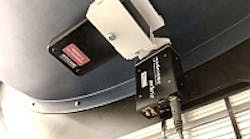Osram Opto's CEO, Ruediger Mueller, highlighted four key areas of growth: miniature projection systems, flat-panel display backlights, automotive headlights and general lighting. As well as reduced cost, these require improved color uniformity and increased surface brightness as key targets.
"LED technology will win where there is proven value over conventional technology; the battle is being fought application by application," said Jason Posselt, product marketing manager for Lumileds. "A focus on light sources, rather than discrete LEDs, will speed the adoption of solid-state lighting technology."
To address many applications, Lumileds has announced a complete redesign of its Luxeon high-power LED product, which when introduced this summer will provide 65 lumens at 350 mA.
In the longer term, Posselt highlighted cost targets of less than 1 cent per lumen, and coupled with hundreds or thousands of lumens per package. When pressed to say when he thought the 1 cent/lm barrier might be reached, he said, "Not this year, probably not next, but definitely within 5 years." Mueller agreed on the 3-5 years estimate, saying it was "inevitable" that production costs would fall.
Coinciding with the show, Cree announced an R&D result of 100 lm/W from a 20 mA white LED in a 5 mm package. While Cree representatives were quick to acknowledge the huge amount of work required to transfer such results into production, the result demonstrates that roadmaps showing progress towards and through the 100 lm/W barrier are not just wishful thinking. Cree's production white LEDs are likely to move to 50 lm/W this year. Meanwhile, Cree has also demonstrated 60-lumen output from its production 7090 white XLamp power LEDs, although it will take several months before this becomes a typical production result.
On the panel, Cree Lighting's marketing manager Chris James showed a timeline graph detailing Cree's progress in the "lumens per wafer" metric for white LEDs. The metric incorporates a number of factors, including efficiency, current density, chip size, yield and wafer diameter. James estimated that Cree's 100 lm/W figure and its ongoing conversion to 3-inch wafer production will bring it close to the 1 million lumens per wafer mark.
Shuji Muguruma of Nichia outlined the company's application focus, which is four areas: lighting, displays, automotive and mobile, with a different product set for each. On its product roadmap for lighting, Nichia has a 5 W package producing 200 lumens. Muguruma also said that Nichia is expanding its Rigel series of 0.5 W devices with products incorporating secondary optics and others targeting LCD backlights, as well as high-power and RGB models.
For Toyoda Gosei, Bill Kennedy presented a range of products, including a new power SMD LED which is due to enter production in April 2005. The device has only 3 components: a 1 x 1 mm chip, the phosphor, and a package measuring 3.4 x 2.8 mm with a depth of 1.2 mm. The package provides "superior" heat dissipation through an inorganic submount, and TG claims it is the world's smallest package capable of handling high current.
Chris James said that over the next five years, the leading companies will move forward thanks to "fundamental scientific strength and materials expertise." Applications will drive LED package form factors, and the LED manufacturers need to supply products that are easy to use by new designer communities, and that can be applied over enormous temperature and power dissipation ranges.
Asia and IP
When questioned about the attraction of moving some of their operations to China, panelists agreed that while some processes benefit from low labour costs, areas such as R&D and process development are best performed in a "special" environment - in part, this was a thinly veiled reference to the need to protect IP.
Osram's CEO, Ruediger Mueller, was more forthright, saying "In terms of IP, if you move to some Asian countries you might as well post your recipe on the internet." He later qualified the remark with reference to the stability of R&D workforces in Europe contrasting with the ease with which many engineers switch jobs in China, according to an Asian study.
Elsewhere in the conference, representatives from organizations in Taiwan and Korea were keen to stress their commitment to IP issues. "IP should be respected," said Pei-Jeh Wang, president of Arima Optoelectronics, one of Taiwan's largest HB-LED producers. "Also, MOCVD growth [of device layers] is an art. If you take some IP and try to reproduce the device layer growth, you won't be able to make a product."
Jed Dorsheimer, a semiconductor analyst with Adams Harkness, said that Taiwan and Korea should not be considered as "IP-unfriendly" countries. "Companies, as well as organizations such as ITRI, have their own IP," he said. "There's a lot of innovation, not just 'me too' products." This includes the development of high-power LEDs by Asian companies outside Japan, notably Cotco and Seoul Semiconductor.
Nevertheless, another speaker described Taiwan as the "bad boy" of international IP, while in this respect China was described as the Wild West (or rather Wild East). IP remains a contentious issue throughout the LED industry, and on the day of the panel session Lumileds issued a press release warning manufacturers of mirror substrate LEDs to check their IP position - or face the consequences.
Standards
No-one on the high-power panel seemed very keen to discuss standards, although Bill Kennedy mentioned the ongoing work in the US of NEMA's solid-state lighting section, and urged interested parties to get involved.
Neither was there a consensus about the best performance metrics to use - lm/W is good for certain applications, while total lumens might be critical for others. Such numbers always need to be qualified with other parameters such as operating current and maximum ratings.




